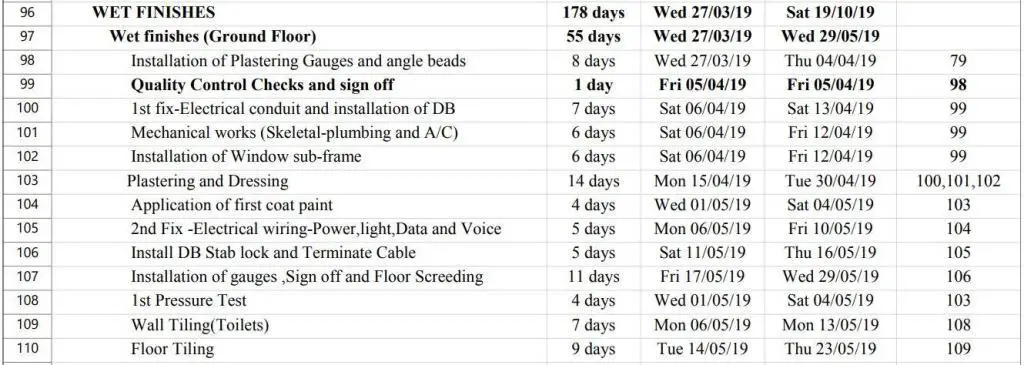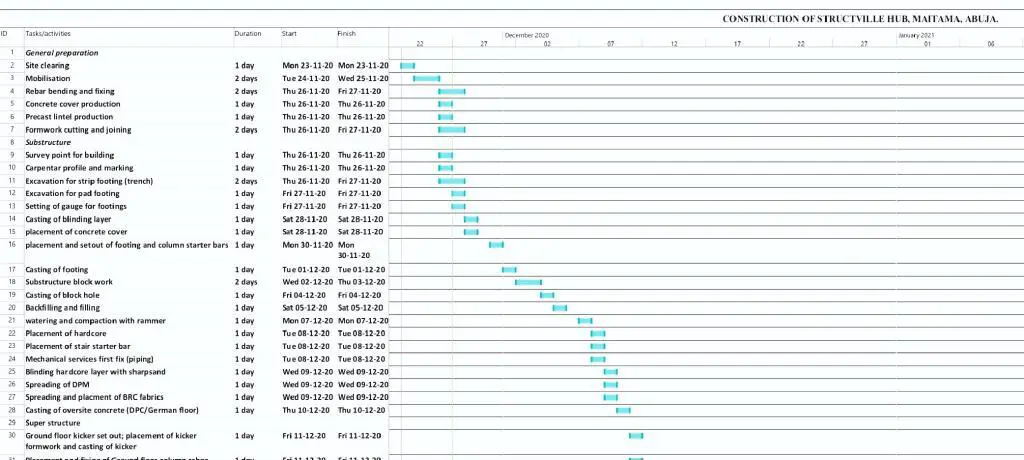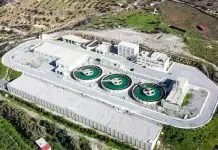To ensure adequate planning and delivery of a project, consultants and clients often require that the contractor submit a programme of work (POW) that shows the sequence of activities that will be carried out in order to meet the expected completion date of the project. A construction work programme is a document that shows the series of work items, their relationship, and the time allocated for their execution. They are like the road map to the proposed construction.
Clients, consultants, project managers, and construction site managers also use POW to plan milestones which is an important tool or key performance indicators (KPIs) for milestone payment or achievement.
The POW can be presented in the form of a Gantt chart showing all the tasks/activities, duration, start and finish date and milestones from site mobilisation to commissioning according to the scope of work. It also serves as a control document to monitor the progress of work with respect to the actual work done. A report could be provided weekly or monthly regarding the status of work to the project stakeholder.

The level of details required from the POW is usually defined by the consultant and it desirably kept simple. However, for POW done for in-house usage, resources may be added. POW is submitted every monthly site meeting to show project progress to project stakeholders. However, when it appears that the progress of work is critically lagging, a request for extension of time (EOT) could be initiated quickly.
Tasks/Activities in a Construction Work
The easiest way to identify tasks in construction is to break the construction work into phases. For typical building construction, these phases can be broken down as follows;
- Pre-construction activities
- Mobilisation and Setting Out
- Substructure (foundation) construction
- Concrete frame works (ground floor to first floor)
- Block work
- Finishes, etc
Under preconstruction activities, tasks such as site clearing, obtaining permission to commence construction, host community negotiations, environmental assessments, harmonization of construction drawings, etc can be identified. Timing and duration can also be assigned to these tasks so as to have a defined target. Under mobilisation and setting out works, all unique tasks involved should also be listed according to the peculiarities of the project.
While construction activities are usually specified in an order, it is possible for two different activities to be going on simultaneously. For instance, reinforcements works can commence while setting out operations are still on-going. The setting of blocks on the ground floor can commence during the casting of columns on the second floor, etc.
Therefore all tasks in a project are identified bearing in mind the resources that are available for their successful completion. All machinery, man-power, materials, and funds needed to execute any item of work should be given special consideration during the preparation of the programme of work. For instance, a contractor who intends to use ready mix concrete and pumping of concrete may not have the same programme of work with a contractor who wishes to use manual labour.
After the activities are defined and set up, another important aspect is to establish the relationship among the tasks. The major importance of this is to figure out the critical path and the best sequence of works. There are some activities which when they are not done can stop almost every other activity on site. For instance, during substructure works, excavation should be done quickly and completely because without it being completed, every other activity is affected.
Tasks in a construction work can be connected to each other in four ways. These are;
- Finish-to-Start (FS): If the activity can’t start without finishing the predecessor activity, it is called an FS relationship.
- Start-to-Start (SS): If for any reason, two or more activities must start together, it is said they have a SS relationship.
- Finish-to-Finish (FF): If two or more activities finish together, they have a FF relationship.
- Start-to-Finish (SF): If an activity can’t be finished until another activity starts, that means they have an SF relationship.
Once the sequence of all the activities has been identified, the project manager can issue the program of work. For simplification, programme of work can also be broken down and handed over the site manager. An example of a simplified programme of work for casting a first-floor slab is given below;

Duration of Tasks
It is important that an experienced execution team be involved in the planning or at least understand how the planning was done. Many projects have failed to achieve proper success because of an improperly thought out timeline assigned to an activity. There are some documents or magazines where someone can pick the duration of works, but the person has to pay proper attention to the conditions that warranted such duration.
In our own point of view, the duration assigned to any item of work should be based on experience. If a comparable item of work has been completed in the past, the project manager should borrow ideas from the project based on the number of workers deployed, the machinery used, the weather conditions, etc. In the image below, we present a simple POW for the finishes of a building.

Advantages of Programme of Works
- It serves as part of KPIs for a project
- Work plans are generated from POW
- Data gathering
- To boost credibility to show understanding of what the scope of the project entails from initiation to closeout.
Special Considerations for Preparation of Programme of Works
- Understanding of the contract documents
- Bill and drawings
- Phasing, milestone, and milestone payment if any
- Scope of work and work breakdown structure
- Method of construction (client and contractor)
- Rate and data for resources allocation to each task/activities
- Weather condition, period of the year, and associated risk(s)
- Cash flow (client and contractor)
- Timeline and cost relationship of task and targets
- Logistics.
Sample Programme of Works for a Residential Building
A simple programme for a building to be completed in 3 months has been attached in pdf format (see below for the screenshot of the attached sample of a construction programme of work). You can download the PDF file below.

PS: We can help you manage your civil engineering projects of any kind inclusive of research, design, and construction. We pride ourselves in excellence and creativity. Send an e-mail to info@structville.com











Another great job from the Engineer himself. Keep up the good job.
Great work.
Very, Very Resourceful.
Please what are the types of programming and its uses
Good morning, please what tool did you use or would you recommend for creating a POW chart just as this?
MS Project or Primavera will work just fine
Microsoft Excel
Jazakallahu khairan
May Allah bless you more bro
This is very helpful. God increase your knowledge
Great post! You’ve clearly explained how a Programme of Work (POW) functions as a crucial planning and control tool in construction. I’d add that integrating the POW with project management software (like MS Project or Primavera) can enhance tracking, automate progress reports, and improve collaboration between stakeholders. Also, using real-time data from site activities can help update the critical path dynamically, making EOT decisions more accurate. Thanks for sharing this valuable insight!